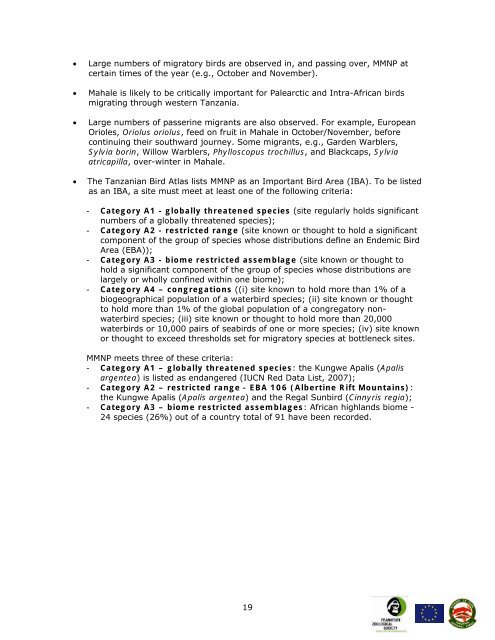Mahale Mountains National Park | Summary of Resource Base
Mahale Mountains National Park | Summary of Resource Base
Mahale Mountains National Park | Summary of Resource Base
You also want an ePaper? Increase the reach of your titles
YUMPU automatically turns print PDFs into web optimized ePapers that Google loves.
• Large numbers <strong>of</strong> migratory birds are observed in, and passing over, MMNP at<br />
certain times <strong>of</strong> the year (e.g., October and November).<br />
• <strong>Mahale</strong> is likely to be critically important for Palearctic and Intra-African birds<br />
migrating through western Tanzania.<br />
• Large numbers <strong>of</strong> passerine migrants are also observed. For example, European<br />
Orioles, Oriolus oriolus, feed on fruit in <strong>Mahale</strong> in October/November, before<br />
continuing their southward journey. Some migrants, e.g., Garden Warblers,<br />
Sylvia borin, Willow Warblers, Phylloscopus trochillus, and Blackcaps, Sylvia<br />
atricapilla, over-winter in <strong>Mahale</strong>.<br />
• The Tanzanian Bird Atlas lists MMNP as an Important Bird Area (IBA). To be listed<br />
as an IBA, a site must meet at least one <strong>of</strong> the following criteria:<br />
- Category A1 - globally threatened species (site regularly holds significant<br />
numbers <strong>of</strong> a globally threatened species);<br />
- Category A2 - restricted range (site known or thought to hold a significant<br />
component <strong>of</strong> the group <strong>of</strong> species whose distributions define an Endemic Bird<br />
Area (EBA));<br />
- Category A3 - biome restricted assemblage (site known or thought to<br />
hold a significant component <strong>of</strong> the group <strong>of</strong> species whose distributions are<br />
largely or wholly confined within one biome);<br />
- Category A4 – congregations ((i) site known to hold more than 1% <strong>of</strong> a<br />
biogeographical population <strong>of</strong> a waterbird species; (ii) site known or thought<br />
to hold more than 1% <strong>of</strong> the global population <strong>of</strong> a congregatory nonwaterbird<br />
species; (iii) site known or thought to hold more than 20,000<br />
waterbirds or 10,000 pairs <strong>of</strong> seabirds <strong>of</strong> one or more species; (iv) site known<br />
or thought to exceed thresholds set for migratory species at bottleneck sites.<br />
MMNP meets three <strong>of</strong> these criteria:<br />
- Category A1 – globally threatened species: the Kungwe Apalis (Apalis<br />
argentea) is listed as endangered (IUCN Red Data List, 2007);<br />
- Category A2 – restricted range - EBA 106 (Albertine Rift <strong>Mountains</strong>):<br />
the Kungwe Apalis (Apalis argentea) and the Regal Sunbird (Cinnyris regia);<br />
- Category A3 – biome restricted assemblages: African highlands biome -<br />
24 species (26%) out <strong>of</strong> a country total <strong>of</strong> 91 have been recorded.<br />
19
















